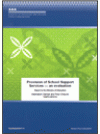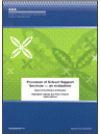This report presents the findings from an evaluation of the provision of School Support Services (SSS). This multi-year evaluation of the provision of SSS was initiated to inform decisions and considerations about future professional learning and development provision.
Purpose
Research evidence shows that what school leaders and teachers know and do is one of the most important influences on what students learn.
In this context, professional learning and development is critical as it enables the Ministry to strengthen the understanding and skills of school leaders and teachers so that they can best meet the learning needs of all students. A multi-year evaluation of the provision of SSS was initiated to better understand aspects of the current system that work or do not work with a view to informing Ministry decisions and considerations about future professional development provision.
Key Results
The Ministry is charged with meeting Government’s goals and aspirations for education. Achieving these goals requires the Ministry to equip schools and teachers with what they need to support all students to learn. The Ministry invests in a range of professional learning and development initiatives to support teachers in New Zealand and the SSS represent a significant proportion of this investment. Key messages that emerged from this evaluation can be summarised as follows:
- Data on access, to determine which schools were accessing or not accessing professional development services offered by SSS, was patchy and inadequate to provide an accurate and nationwide picture of schools that participate in professional development. As a result, it was not possible to undertake any trends analysis or identify patterns in the profile and mix of schools accessing professional development from SSS. The evaluation highlighted the importance of this data to build a comprehensive picture of the use of professional development services offered by SSS. In response to this, the Ministry revised the data-collection templates from 2008 onwards, requiring providers to provide more detailed information about delivery of PLD to schools in their region. This allowed the Ministry to build a nationwide picture of access more easily.
- There was variability in the processes and criteria used by providers with respect to school selection. The evaluation found, for instance, there was no systematic or explicit approach to school selection, and schools felt processes around selection lacked transparency. The selection of school tended to be demand-driven (schools that asked for PD received it) and/or network-driven (schools that had a prior relationship with advisors tended to have easier access to the service) and/or through referrals (where schools were referred to the service by the regional Ministry office). More importantly, the findings indicated that there were no explicit criteria for school selection, creating a perception among some school leaders that the resources were not being used efficiently and effectively.
- The delivery of PLD is strongly driven by expectations and aspirations set out in the SSS contracts. The school support services are a collection of professional development services that the Ministry purchases for schools that allows the Ministry to meet government’s commitment to education. The services purchased are varied annually to respond to government priorities. Consequently, the contracts offer the Ministry a tremendous opportunity and leverage to shape and influence PLD delivery by ensuring that the contracts are well written and provide a clear direction about Ministry expectations for a given year. Changes introduced to the 09/10 contracts requiring providers to focus on a smaller number of high-priority areas and prioritising support for schools and students that need it most sent a clear signal about current government’s focus on lifting student achievement.
- There are a number of Ministry–funded professional development providers and there were significant differences in how these PD contracts were designed, managed and implemented by the Ministry. This created confusion as schools received support from more than one Ministry-funded professional development provider at any given point in time. These variations meant that schools experienced these contracts differently even though they were run by the Ministry, and led to mismatch in expectations as the resources across these contracts were not spread evenly.
- There was an expectation from the National office (responsible for overseeing the contract) that SSS providers would consult with regional Ministry office to identify regional needs and priorities. The evaluation found that these links and relationships were not being exploited sufficiently and regional Ministry office felt excluded from these contracts, resulting in missed opportunities for using regional intelligence when prioritising or selecting schools. These issues were addressed in the 09/10 contracts and there is a now a clear expectation that regional Ministry office would have an active role in the prioritisation and planning processes. The formative evaluation to examine how these plans are playing out revealed that there are significant issues that could impact on the success of this approach/model. These relate to perceived capacity and capability constraints within the regional Ministry offices; lack of clarity around roles and responsibilities; and lack of involvement in the setting of the SSS contract outputs and focus areas.
- The provision of leadership and management support through SSS was part of a wider Leadership Strategy aimed at providing professional learning and development support to principals. In addition to the SSS contracts (focused on first-time principals, aspiring principals, principals in at-risk schools and middle leaders) there were other initiatives such as the Principals Development Planning Centre, focused on providing professional development to experienced principals. The evaluation found that provision of services with respect to leadership and management across the four priority groups identified in the SSS contracts was uneven. The commonly-held view was that first-time principals and principals in schools at-risk absorbed the bulk of the resources. This limited access to the service by school leaders in general.
- The way in which in-depth PD work was delivered to schools was viewed positively by participating schools. As noted earlier, the selection of schools tended to be demand-driven rather than driven by need, which meant that schools that were most in need did not always receive or have access to the support. The evaluation also showed that monitoring success or impact of the in-depth PD tended to be limited to content and pedagogical shifts while other areas of school development, critical to sustainability, were often ignored. Maximising value of the in-depth PD offered to schools requires consideration of impact at all levels: at an individual teacher level; at a department or syndicate level; across all teachers in the school; and at a school/institutional level. The evaluation findings highlight an opportunity for the Ministry to redirect providers’ focus and efforts to ensure the support provided is cognizant of the wider system in which the teacher operates. That is, as well as effecting change at an individual teacher and/or syndicate and/or department level, support provided through SSS also responds to issues or constraints in the wider school environment. This can be achieved through specific support provided to a range of groups including school leaders, middle leaders, teachers, provisionally-registered teachers and their mentors, and overseas-trained teachers. Regardless of the group being worked with, advisors can and must be encouraged to work towards leading change within the school.
- Notions of sustainability are central to SSS and the Ministry had an expectation that sustainability goals and principles were built into the design and delivery of professional learning and development support. The evaluation highlighted a high level of variability across providers in this regard and, while in some instances there was intentionality around sustainability, there were other instances when sustainability conversations occurred when the PLD came to an end. This left schools with an acute sense of loss and a feeling of being ‘left in the lurch’. To ensure goals of sustainability are achieved, there is a need for a deliberate and planned approach to sustainability.
- Monitor progress in ways similar to how effectiveness of PLD is tracked. This needs to begin with a shared definition of what exit means and a common understanding across providers as to why exit matters.


